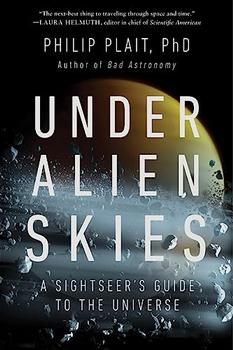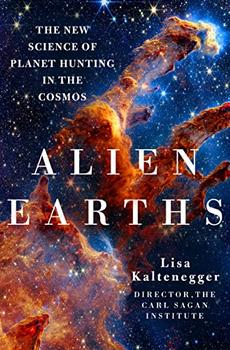Summary | Excerpt | Reviews | Beyond the book | Read-Alikes | Genres & Themes | Author Bio

A Sightseer's Guide to the Universe
by Philip PlaitWhat would it be like to go for a hike on Mars? What adjustments would you have to make to live on a planet with two suns? Dr. Philip Plait's nonfiction book Under Alien Skies not only explores how things are different on other planets, but also what the human experience of those differences might be like. Plait begins with the astronomical object closest to our reach—our own moon. His descriptions of what a vacation on the Moon might look like cover both the wondrous aspects, such as how the view of Earth would change depending on where the Moon is in its orbit, and potential pitfalls, such as the fine dust known as regolith that can damage both machinery and human lungs.
From the Moon, the book takes the reader ever farther from home. Approximately the first half of the book is dedicated to objects within our own solar system, covering Mars, Saturn, Pluto and various types of asteroids and comets. Scientific facts are continuously related to human experience. The reader not only learns about Martian dust devils and how the rubble-pile theory of asteroid make-up works, but also the dangers of lightning in dust storms and the challenges of trying to walk on such an asteroid without being buried in rubble or launching yourself off the surface due to low gravity.
The last five chapters explore less familiar parts of the universe, including planets orbiting red dwarf stars and binary star systems (systems made up of two stars orbiting each other), planets inside globular clusters (spherical groups of many stars—sometimes millions!—packed closely together) and the space around nebulae and black holes. These chapters necessarily contain more theoretical discussion, given that current knowledge means the author cannot select specific planets to focus on. Plait explains how the search for exoplanets (planets orbiting stars other than our own sun) has developed. From there, readers learn about different classifications of stars, such as small and dim red dwarfs, which are the most common stars in our galaxy. The book details the ways in which a binary star system might function and how scientists have figured out how old globular clusters are based on the mass of their stars. For each system, Plait theorizes about where a planet of that system would need to be located in order to be potentially habitable.
This is an excellent introduction to a wide range of theories relevant to astronomy, which are very well explained and easy to follow despite their complexity. There are not a large number of diagrams, but those included are easy to parse. Additionally, the book contains eight pages of color pictures illustrating some of the main points. The author also makes note of when ideas are being simplified or imperfect metaphors are being used. Readers with a strong background in physics may find the explanations somewhat basic, as the book is written to be approachable to a wide audience.
The tone is warm and friendly, and often quite funny. Each chapter includes sections of fictionalized descriptions of what it would be like if the reader could actually visit these alien worlds. These are charming, but also might be considered the weakest part of the book. The descriptions of what the hypothetical "you" is seeing and doing are fascinating, but "your" responses to these experiences start to feel a bit repetitive.
Under Alien Skies allows readers to connect with astronomy in a very personal way. It not only makes difficult science understandable, but also helps to translate that science into an amazing voyage it's unlikely anyone alive today will get to see firsthand. It's a fun and fascinating read that would be an excellent choice for the layperson who wants to explore our universe.
![]() This review was originally published in The BookBrowse Review in April 2023, and has been updated for the
April 2024 edition.
Click here to go to this issue.
This review was originally published in The BookBrowse Review in April 2023, and has been updated for the
April 2024 edition.
Click here to go to this issue.

If you liked Under Alien Skies, try these:

by Lisa Kaltenegger
Published 2025
Riveting and timely, a look at the research that is transforming our understanding of the cosmos in the quest to discover whether we are alone.

by Helen Czerski
Published 2024
A scientist's exploration of the "ocean engine"—the physics behind the ocean's systems—and why it matters.
Your guide toexceptional books
BookBrowse seeks out and recommends the best in contemporary fiction and nonfiction—books that not only engage and entertain but also deepen our understanding of ourselves and the world around us.